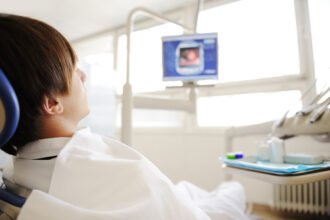 A new robotic device designed to help those with paraplegia stand and function as if they were walking is expected to hit the market as early as next month.
A new robotic device designed to help those with paraplegia stand and function as if they were walking is expected to hit the market as early as next month.
 A new robotic device designed to help those with paraplegia stand and function as if they were walking is expected to hit the market as early as next month.
A new robotic device designed to help those with paraplegia stand and function as if they were walking is expected to hit the market as early as next month.
Known as the Tek Robotic Mobilization Device or Tek RMD, the device debuted in 2012 and is the first of its kind to have been launched by Matia Robotics. Founded in 2006, Matia Robotics strives to improve the lives of people with disabilities by enhancing their health, wellness and level of independence.
Matia Robotics CEO Necati Hacikadiroglu, along with several team members, invented Tek RMD based on the specific needs of those with paraplegia, said Steven Boal, who serves on the Board of Directors.
“As you know, when a person is paralyzed from the waist down, they lose the use of their legs but their upper body still has its full function. So, if you can support their legs in such a way that leaves the hands free, they can do everything they used to do with their upper body,” Boal said, adding, “What they needed was a device that will support their legs without taking up any additional space and that will not restrict or limit their upper body functions. (Hacikadiroglu) developed the TEK Robotic Mobilization Device based on these considerations.”
According to the company’s website, there are many benefits to using the Tek RMD.
Ease of Use
Those who are paralyzed often have difficulty transferring into wheelchairs. According to the website, during the transfer process, they “have to lift their body with their arms and throw themselves onto their wheelchairs in order to transfer their body from a bed or a chair. This motion of throwing the body is difficult, dangerous and almost impossible to do without assistance.” Users can access the Tek RMD from the back of the device while seated, making the process easier and safer.
Tek RMD also holds users in an upright position so they do not need to hold on. This enables users to perform routine tasks, such as cooking or ironing. “Movements that require both hands, such as carrying a tray can be easily done with the use of the remote control. Additionally the user can enjoy being at eye level with other people in their daily life,” the site states.
Health and Wellness
Those with paraplegia are encouraged to remain in a standing position for an hour each day. Using wheelchairs that can adjust to standing position can take a great deal of time and effort and do not always get the person fully upright. Matia Robotics claims it is quicker and easier to sit and stand with Tek RMD. “The suspension system containing gas spring balances the weight of the user so that standing up requires just a gentle pull. From the moment they wake up, users can board the device and stand up without needing assistance from others. This comfort encourages the users to stand up countless times, and to do various daily activities while standing up,” the site states.
Size
Matia Robotics touts Tek RMD as the world’s smallest motorized standing movement device, making it easier to maneuver through small spaces and narrow doorways. The device is also able to maintain its balance—in spite of its small size—because “it grabs the users from the balance points and prevents any misuse or unwanted movements that would result in a loss of balance,” the site states.
Boal said user responses to the Tek RMD have been very favorable. In fact, Yusef Akturkoglu, who became paralyzed after falling from a horse several years ago, has found it to be quite liberating. “At first I was very nervous. The idea of being able to stand up was spooky. I mean, I did stand up over the years during physical therapy but with this, you do it on your own, so it was weird. Then I stood up, and it was great,” Akturkoglu said.
There are more perks to using the Tek RMD than what the company describes online, Akturkoglu said. “After many years, I was (finally) at the same eye-level with people around me. (I enjoyed being) able to go around without people pushing you from behind, to use the toilet, to sit and stand, to see inside of a pan while cooking, cleaning (and) countless little things you can do. But the best part is, this device gave me the option of being alone. If you are disabled, you always need someone around you to do things for you. This saddens you. With this device, I can just stay home alone.”
Based on the feedback they’ve received so far, Boal expects the Tek RMD to be in demand for quite some time. “We have been approached by potential users and hospitals from all over the world. Our team is working day and night to take the necessary steps to start delivering the devices to users,” Boal said, noting that production will be limited.
Those who are interested can find more information and even make a reservation at http://www.matiarobotics.com.
According to Boal, Matia Robotics is currently in the final stages of completing the European certification process and expects to begin production as early as next month. “First deliveries to rehab centers and a number of people who reserved an early position in the production line will commence in March,” he said, adding, “We are also in discussion with distributors who wish to sell and service the devices in various countries. As these are confirmed, they will be published on the website.”
When it comes to the United States, the FDA must grant approval before Tek RMD can be sold to consumers, Boal said. The device is also not yet covered by insurance companies and retails for about $15,000 in the United States, shipping not included.
“We are very conscious of the desire to have the device approved by the various reimbursement agencies. We are very confident we can demonstrate a very strong economic argument for them to include the device in their approved lists. We can demonstrate the user’s independence will reduce care cost. Also, not having the need to modify homes to accommodate wheelchairs and the improved general health (due to) simply standing and regularly transitioning from sitting to standing position will be a benefit,” Boal said, noting, “We cannot start that process until we have the product approved by the various country authorities. So, for the near future, this is a self-pay option.”
In the meantime, Matia Robotics is working on its next big thing. “Our goal has always been to develop technology that will help people—specifically people with walking disabilities,” Boal said. “Tek RMD is our first product to hit the market. Once it does, our R&D team will start working our next device, which we believe will be as game changing as the Tek RMD. We have the idea, drawings, and even applied for patents; we just need the time to take the concept and make it into a product.”
Kelly Rouba of The Mobility Resource contributed to this story.







